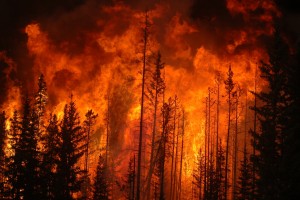From the temperate Pacific rainforests of British Columbia to the old French architecture of Montreal, the chilly, vital Arctic to Banff National Park, considered by many to be “the zenith of the entire Rocky Mountains,” Canada is incredibly beautiful and full of wonder. But all that wonder is at risk.
“The environmental threat to our world is greater than any time in human history. Just look around. We’re already seeing the impacts of climate change seared across the world,” says the Catherine McKenna, Canada’s minister of environment and climate change.
“Average temperatures in Canada have already increased by 1.7 degrees Celsius since 1948. Continued amplification of warming at high latitudes is projected under all scenarios of future climate change,” McKenna explains. “Along with higher temperatures and increased rainfall, we will see rising sea levels. Warmer waters and ocean acidification are expected to become increasingly evident over the next century.”
The nation has experienced a higher rate of warming than most other regions of the world, particularly in its far-north and west. This warming has been most pronounced in the winter and springtime, and it’s leading to a number of major impacts across the country. These include permafrost and ice melt in the Arctic, sea-level rise, and more frequent and severe extreme weather, such as once-uncommon heat extremes and major changes in precipitation.
The Arctic is an incredibly important and very fragile ecosystem – and it’s warming at a much faster rate than much of the rest of the world. Scientists are already seeing dramatic reductions in Arctic sea ice cover, particularly in the summertime. This shrinking sea ice disrupts normal ocean circulation and creates changes in climate and weather around the globe.
For the minister, seeing the human impacts of this warming on her fellow Canadians has hit by far the hardest. “This is not a matter of inconvenience to the Inuit – the melting of the sea ice and permafrost threaten the Inuit way of life and their very survival. The consequences are painful and profound.
Canada is largely thought of as a temperate-to-cool country, one insulated for the most part from the worst sorts of extreme weather. Or at least it wasn’t for much of the nation’s history. The last few decades, however, have brought dangerous changes to Canada’s climate and weather.
“In the Canadian West, wildfires rage stronger and harsher than ever before. We’ve witnessed cities and homes burning, ranchers losing their stables – and each fire season, more communities displaced by the flames,” McKenna explains. “On the prairies, droughts and floods occur with increasing frequency, and produce greater devastation for families and farmers whose homes and businesses are harmed.”
These devastating events are being driven in large part by ever-rising temperatures and changes in precipitation patterns. On average, Canada has become both warmer and wetter. But the amount and distribution of rain, snow and ice across Canada has also shifted.
Like so many places around the globe, Canada has seen an increase in hot extremes. Intense heat can have a serious impact on human health, and – thanks at least in part to climate change – days of extremely high temperatures and poor air quality are only becoming more frequent. Worse, these days hit vulnerable populations in urban centers the hardest – specifically, babies, children and seniors, as well as people who work outdoors or are already ill.
In early July 2018, the southern part of the Canadian province of Québec endured one such period of sweltering heat – and it took the lives of up to 54 people, most of them between the ages of 50 and 85. These changing circumstances also likely played a major role in the nation’s most destructive wildfire ever, when more than 88,000 people were evacuated from Fort McMurray in Alberta in May 2016. More than 2,400 homes and other buildings were destroyed.
“From 1983 to 2004, insurance claims in Canada from severe-weather events totaled almost $400 million a year. In the past decade alone, that amount tripled to more than $1 billion a year. Climate change is expected to cost Canada’s economy $5 billion a year by 2020, and as much as $43 billion a year by 2050. Inaction is simply not an option,” McKenna explained.
Driven by melting land ice and seawater warming and expanding, global sea levels could rise by as much as a meter, or perhaps even more, by the end of the century. Canada is a maritime nation. Eight of its 10 provinces and all three territories border ocean waters. That puts the western Arctic, Canada’s southeastern Atlantic Coast and major cities like Vancouver and Halifax right on the front lines of sea-level rise.
With oceans rising faster than at any time in almost 3,000 years and Antarctic ice loss now believed to be nearly three times greater than earlier estimates, there’s great cause for concern. Rising seas and increased storm surge height may cause flooding all along the country’s Atlantic, Pacific, Arctic and Beaufort Sea coasts, allowing salt water intrusion into some inland areas, potentially contaminating ground and surface freshwater.
“In our big, cold country on the upper half of North America, the environment impacts where Canadians live, how we work and how we see our future. Canadians, including myself, are focused on ensuring that we protect our environment all while creating good jobs and making sure our businesses are positioned to compete as we move to a cleaner and more sustainable future,” McKenna says.
